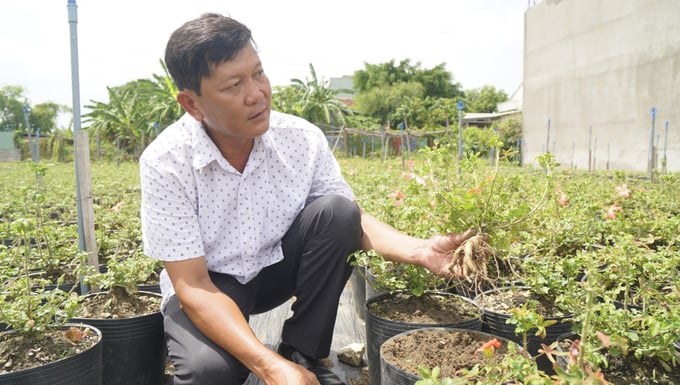May 31, 2025 | 17:13 GMT +7
May 31, 2025 | 17:13 GMT +7
Hotline: 0913.378.918
May 31, 2025 | 17:13 GMT +7
Hotline: 0913.378.918
During the peak of the Covid-19 outbreak in 2021, all production and trade activities in Binh Dinh were "frozen." Tran Minh Tam, a man with 50 years of age, felt disconnected and frustrated after he must halt all businesses such as bread, moon cake, incense making, and catering. He strolled throughout the area, then stopped by his brothers' house on Kim Chau street (Binh Dinh ward) to relieve his heavy mind.
While having a chat, Bac, Tam's brother, was given some Bo Chinh ginsengs (Abelmoschus sagittifolius (Kurz) Merr) by a friend traveling from south to north. Bac then offered Tam seven roots, explaining that it was initially known as "a precious ginseng that was offered to the king" and was úed as medicine for the first time in the Bo Trach district by legendary physician Hai Thuong Lan Ong in the 14th century (Quang Binh).

Tran Minh Tam visiting the ginseng garden. Photo: V.D.T.
Tam carried the perennial herbs home with him and planted them in the yard as a way to make use of his time during the pandemic. Tam began to study more about this ginseng after seeing how well it grew, particularly from the "farmer column" and articles about agriculture of FAO. One after another, he learned nursery, cultivation, and ginseng plant care skills.
From the initial seven roots, Tam was capable of replicating and planting a few dozen more, then he increased to 40-50 roots while waiting to see how they adapted to the local weather and environment. Tam gained knowledge and developed his own planting method during that trial period.
Tam instantly decided to resign all business to return to agriculture and start a business with Bo Chinh ginseng after seeing that Bo Chinh ginseng root was ideal for the local temperature and soil. The plant grew and developed steadily, and the size of its root could rival those cultivated in other regions.

The ginseng garden started with 20,000 potted plants by Tam. Photo: V.D.T.
In order to ensure food safety, Tam did not use chemical pesticides in the production process, instead he would use biological treaments if any ill plant was spotted. "When I reproduced 20,000 potted ginseng plants on an area of more than 0.5 ha, I poured 20 carts of dirt, 500 bags of rice husks, 400 bags of ash and peanut shells to mix with the soil so that the soil would be fresh and spongy before i put the pots in," said Tam.
In 2022, Binh Dinh Farmers' Association hosted the first "Creativity Farmers" and "Innovative Farmers" contests in Binh Dinh province in partnership with the provincial Department of Science and Technology. Tam was invited by Binh Dinh ward's functional department to participate with his Bo Chinh ginseng cultivation model. "From the ward to the provincial level, I was lucky enough to earn first place in my first contest for the first time. After winning, I went to take on the regional contest, then the national contest in An Giang," Tam said with a joyful tone.
"Up to now, I can finally give open remarks about the productivity of Bo Chinh ginseng in this area as the 20,000 pots I planted earlier this year have been harvest. "I can collect 170 - 180 grams of roots per plant on average. if I can achieve 200 grams of root per plant, the farmer will fetch a more lucrative profit".

Laborers working in Tam's ginseng garden. Photo: V.D.T.
Bo Chinh ginseng roots planted in Binh Dinh is not losing to any ginseng grown elsewhere. "If 30 neighboring plants are plucked out, there will be 18 out of 30 roots gain a size of 1 kg/6 roots, and the remaining 12 are smaller, reaching 1 kg per 8 roots," Tam explained.
According to his calculation, harvesting 20,000 potted ginseng plants will yield roughly 4,000 kg of roots. The current retail price for 1 - 2 kg is VND 700,000 - 800,000/kg, while anyone who purchases 10 kg or more would receive a discount of VND 600,000/kg.

Tam regularly checks the growth of the ginseng root to adjust the technical process of growing ginseng for himself. Photo: V.D.T.
After selling 10kg of ginseng for 6 million VND, minus the cost of three harvests and preliminary processing, Tam still had more than VND 5.3 million left. He regularly picked ginseng flowers and leaves every week to preliminarily process and sell at the market. From sowing until harvesting, with investment in seedlings, fertilizers, care to biological pesticides, each plant costed him VND 54,000. And for the first 20,000 ginseng plants, Tam spent a total of VND 1 billion. "Having harvested over 4,000 kg of roots, now I could sells 1 kg of roots for VND 600,000 on average. I will make more than VND 2 billion. Excluding all expenditures, I will still gain a profit of more than VND 1 billion".

Tam is attached to his own start-up ginseng garden. Photo: V.D.T.
Tam currently rents almost 2 ha of property suitable for producing crops in residential group 3 of the Kim Chau neighborhood and nearly 2 ha in the Phu Cat district to extend the ginseng growing are, in addition to 20,000 potted ginseng plants.
Translated by Linh Linh

(VAN) Seafood by-products are opening a new path, combining green growth and technological innovation to enhance the industry's value.

(VAN) Mr. Nguyen Thanh Cong, Vice Chairman of the Son La Provincial People's Committee, reflects on Son La’s journey from barren hills to fruitful orchards after a decade of hard work.

(VAN) FAO’s Director-General addresses the 5th Baghdad International Water Conference.
/2025/05/26/1716-4-nongnghiep-191706.jpg)
(VAN) Chain linkages, technological innovation, and raw material zoning are three strategic pillars for the coconut industry to strongly develop and elevate its position on the global agricultural map.
![Advanced mariculture – an inevitable trend: [4] Accompanied by scientists](https://t.ex-cdn.com/nongnghiepmoitruong.vn/608w/files/sohk/2025/05/13/1941-pgsts-vo-van-nha-140958_717.jpg)
(VAN) According to Assoc. Prof. Dr. Vo Van Nha, Director of the RIA III, the development of advanced offshore mariculture is no longer an option but an essential path for Vietnam’s fisheries sector.

(VAN) Vietnam is intensifying the development of mollusk farming areas that meet international standards, aiming for sustainable growth and enhancing its export position in the global seafood market.
![Advanced mariculture – an inevitable trend: [3] Policy-driven momentum](https://t.ex-cdn.com/nongnghiepmoitruong.vn/608w/files/doanhtq/2025/05/21/0104-0616-0348-nuoi-bien-170339_789.jpg)
(VAN) To ensure the success of offshore mariculture that uses advanced technologies, it is essential to establish supportive policies that inspire both individuals and enterprises to invest with confidence.